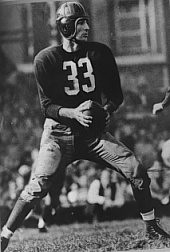Most football fans are familiar with the idea of a "system quarterback." The term is used, often derisively, to refer to a QB whose success is more attributable to the offensive scheme in which he plays than to his own unique abilities. System quarterbacks are not uncommon in college, where athletes cycle through a program quickly, and coaches have maybe four years, at most, to turn a raw recruit into a finished passer. Under those conditions, it might make sense for a coach to insist that every quarerback who plays for him adopt the same mechanics (though it doesn't do much to get the QBs ready for the pro game, as Jeff Tedford's various proteges -- Trent Dilfer, Akili Smith, Joey Harrington, Kyle Boller, Aaron Rodgers -- could tell you).
On the NFL level, however, "system quarterbacks" don't exist. Or perhaps it's better to say that every NFL quarterback is a system quarterback. That's because a pro quarterback simply isn't going to be successful unless he plays in a system that fits his skills. The difference is that in the NFL, the system is molded to fit the quarterback, whereas in college, it's the quarterback who is molded to fit the system. Critics of Peyton Manning like to allege that if, say, Tom Brady had the type of talent around him that Manning has, then Brady would put up the kind of numbers that Manning does. But a smart coach wouldn't build the same team around Brady as he would around Manning, because the two have different strengths. And if you were to put Manning or Brady -- or Carson Palmer or Drew Brees -- in the system designed for Donovan McNabb, none of them would do as well as McNabb.
System players do exist in the NFL, just not at quarterback. The Denver Broncos' now-famous running-back carousel is a prime example. With the exception of a few elite players, NFL running backs are mostly interchangeable. The Denver coaches take these interchangeable rushers and give them a very simple instruction: Make one cut, and one cut only, behind the line before hitting the hole. No dancing around in the backfield. Combined with the Denver offensive line's zone-blocking (some may say cut-blocking) scheme, this system has turned a succession of backs into 1,000-yard rushers. As a bonus, the Broncos have been able to use two of these backs as trade bait to acquire the best pair of cornerbacks in the league: Champ Bailey, who came from Washington in a trade for Clinton Portis, and Dre Bly, acquired from Detroit for Tatum Bell. Then Denver just plugged two more runners into their system (Reuben Droughns after Portis, Travis Henry after Bell).
In Thursday night's season opener, we saw a system cornerback in action. That cornerback was Jason David of the New Orleans Saints, and, unfortunately for him, the system was all wrong.
David spent the first three years of his career with the Indianapolis Colts. Last offseason, he signed with the Saints for $15.6 million over four years. Because David was a restricted free agent, the Colts had the right to match the offer, but they declined. Thursday, David's first game in a Saints uniform came against the ... Colts. You know how it went: Though David returned a fumble for a touchdown, he was also torched for 150 yards and three touchdowns. Colts receivers repeatedly blew right past David on their way to the end zone.
After the game, Manning was asked whether Indianapolis targeted David because he used to be a Colt. He was nice enough to say that "we don't do that," but it was obvious that they do -- and did. Further, other teams on the Saints' schedule will be targeting David for the same reason: because he used to be a Colt. It's a matter of system.
David had spent his entire NFL career in Indianapolis, which is where he learned how to be an NFL cornerback. The Colts play a variation of Cover-2, a zone defense in which cornerbacks are responsible for covering receivers within about 15-20 yards of the line of scrimmage. After that, the corners release their receivers to the safeties, who play deep. The Saints, however, play man-to-man defense. Corners are responsible for covering receivers all the way down the field. What's key to understanding David's catastrophic performance Thursday is that when he played for the Colts, he always had safety help over the top. If a receiver got past him, at some point it became someone else's responsibility. But now he doesn't have that safety help. Once a receiver gets past him, he's gone.
NBC replays Thursday night showed over and over just how ill-suited David is to the Saints' defense, at least at this point in the season. David was taught to try to spy the backfield -- watch the quarterback for an indication of where the ball is going. You can do that when you play zone, because you're responsible only for a designated portion of the field. You cannot do it when playing man coverage. You have to keep your eye on the receiver, not the quarterback.
As the season progress, we'll see whether David can adjust or whether he turns out to be a free agent bust. It'd be harsh to call him a "bust," of course, because he isn't a bad player. He's just in the wrong system.
Subscribe to:
Post Comments (Atom)


No comments:
Post a Comment